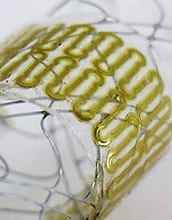Sensor would be implanted in the blood vessels of the human brain
.
A wireless sensor small enough to be implanted in the blood vessels of the human brain could help clinicians evaluate the healing of aneurysms — bulges that can cause death or serious injury if they burst.
.
The stretchable sensor, which operates without batteries, could be wrapped around stents or diverters implanted to control blood flow in vessels affected by the aneurysms. To reduce costs and accelerate manufacturing, fabrication of the stretchable sensor uses aerosol jet 3D printing.
.
The device is believed to be the first demonstration of aerosol jet 3D printing to produce an implantable, stretchable sensing system for wireless monitoring. “The beauty of our sensor is that it can be seamlessly integrated onto existing medical stents or flow diverters that clinicians are already using to treat aneurysms,” said Woon-Hong Yeo, a biomedical engineer at […]
Case Study: How PepsiCo achieved 96% cost savings on tooling with 3D Printing Technology
Above: PepsiCo food, snack, and beverage product line-up/Source: PepsiCo PepsiCo turned to tooling with 3D printing...





0 Comments